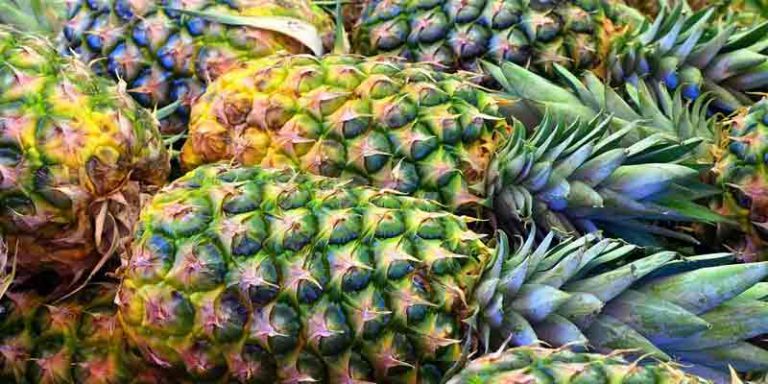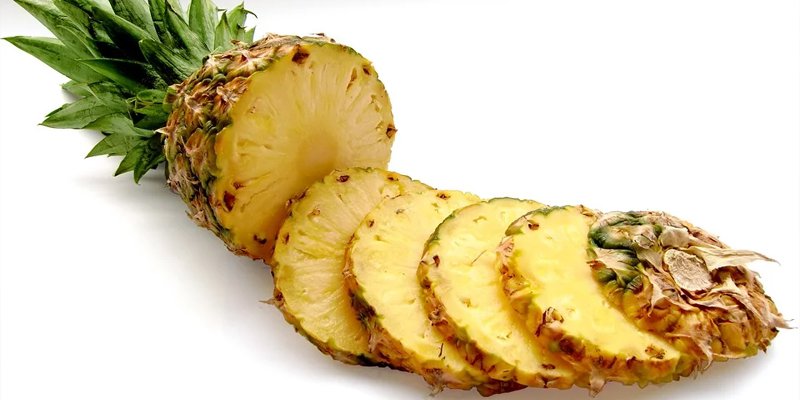Pineapple is a tropical fruit that’s popular and eaten all over the world. Whether you’re using it to make a fruit salad or other popular desserts, pineapple makes a great addition. Therefore, most people will buy a couple of pineapple at a time to keep for use later. Sometimes, you have other plans and forgot about the pineapple you’ve bought. So then, you’re probably wondering: does pineapple go bad?
So does pineapple go bad? Yes, pineapples do go bad if they are not stored properly. If kept at room temperature, they will start to rot after 1-2 days. In the fridge, most pineapple will go bad after 5 days.
Pineapple Shelf Life
| Pantry/Room Temperature | Refrigerator | Freezer | |
|---|---|---|---|
| Whole Pineapple | 1-2 Days | 4-5 Days | Not Recommended |
| Pineapple chunks or slices | 1-2 Hours | 3-4 Days | 5 Months |
| Canned pineapple | Best By Date + 3 Months | Best By Date + 3 Months | Not Recommended |
How Long Do Pineapples Last
Due to the high content of the liquid in pineapple, they don’t usually last that long. Pineapple will start losing its freshness right after it’s harvested.
A whole pineapple will last for about 1 to 2 days at room temperature before it starts to go bad. In the fridge, due to cooler temperature, the pineapple can last 4 to 5 days.
When it comes to cut pineapple, it should never be left at room temperature for more than 2 hours, especially on a hot day. They will begin to get mushy and soft, and bacteria will start growing on them.
In the fridge is the best place to store pineapple slices and chunks. 3 to 4 days in the fridge is the average time you can expect them to retain their freshness. After that time, due to the moisture in the fridge, they will slowly lose their quality. It’s still safe to eat them, but it won’t taste fresh.
As for canned pineapple, there will usually have a “Best By” date on the label. Just like any other canned food, it can last for a very long time. The pineapple will last for months past its printed date. This applies to canned pineapple slices and pineapple chunks.
How to Store Pineapples
Since it’s difficult to tell when the pineapple was harvested if you’re buying them at the grocery stores, they should always be stored in a cool place.
At room temperature, the pineapple should be stored in the pantry where it’s cool and dry. Leaving them on the counter where it’s exposed to heat and light from the sun will decrease their shelf life rapidly.
In the fridge, you can store the pineapple as a whole if you have space to store them. Otherwise, it’s best to cut them into smaller pieces and store them in the fridge.
When keeping a whole pineapple in the fridge, don’t wrap anything on them and put them in the crisp section of the fridge. Wrapping them in plastic wrap could cause them to rot prematurely due to the moisture in the fridge.
For pineapple slices and chunks, they should always be stored in an airtight container or a resealable plastic bag. When placing the pineapple pieces in the container, leave about half an inch of space at the top. Doing so ensures that the pineapple is not tightly packed which prevents them from bruising.
If you’re using a plastic bag, leave enough space, so you can seal the bag. Also, make sure to squeeze out as much air as possible to avoid the pineapple from spoiling prematurely.
Lastly, canned pineapples should be stored like you would with other canned food. The pantry or cupboard is the ideal location for storage since it’s cool, dry, and dark. The less light and heat the canned pineapple is exposed to, the longer it will last.
Can You Freeze Pineapple?
For long-term storage, freezing pineapple is a great option. Since pineapple is more than 70 percent liquid juice in them, they freeze really well in the freezer.
When freezing pineapple, it’s best to cut them into the desired pieces and freeze them. Freezing the whole pineapple is fine too, but it’ll probably take a while to freeze and take up a lot of space in the freezer too. For this reason, it’s best to cut them into smaller pieces, so you’ll have more space to store other food.
Depending on how much pineapple you’ll use, you can either freeze all the pineapple in a single bag or flash-freeze each piece. If you’re going to use a large amount of pineapple, it’s best to put them into a single bag. On the other hand, if you’re going to use only a couple of pieces at a time, flash-freezing them is recommended. Doing so will be easier for you when you need to thaw them.
Another option would be to freeze pineapple juice. Freezing just the juice will help save space in the freezer. Also, you can use pineapple juice for cooking, making desserts, and smoothies.
How To Tell If The Pineapple Has Gone Bad
Pineapple tends to go bad when it’s exposed to heat for a long time. However, before it actually goes bad, the quality will degrade first. This will give you some time to consume it or prepare them for storage.
One of the signs to look for in a pineapple that’s about to go bad is to look at the leaves. The leaves will start to lose color and dry out. At this point, it will start to deteriorate quickly, especially if it’s sitting at room temperature.
Due to the high content of the liquid in a pineapple, mold will usually start growing on them when it has gone bad. Look at the bottom of the pineapple and see if it’s mushy and wet. When that happens, mold will start growing on it.
Another place to look for mold is under the skin of the pineapple. Cut the pineapple and examine the area under the skin. When it has gone bad, the area will be mushy and has mold growing.
Depending on how much mold grows on the pineapple, it is still safe to eat the pineapple. If there are just small spots of mold on the fruit, simply cut the area that has mold on it and throws it away. However, if there’s a large amount of mold on the pineapple, it’s best to just throw the entire fruit away.
Besides mold, another thing to look for is browning on the flesh of the pineapple. Browning occurs when the flesh starts to rot and causes it to lose its yellowish color. Additionally, you’ll see white spots, which are bacteria growing in and around the browning area as well. When you see this, cut the area that’s bad and throw it away. Again, if browning occurs all over the pineapple, it’s best to discard the entire fruit.
When it comes to canned pineapple, the only sign to look for is if the can have a leak, bulged, or rusty. Otherwise, it’s safe to eat the pineapple.
Related Questions
Is it OK to eat overripe pineapple?
Overripe pineapple is safe to consume and cook with. The only time when you’ll need to discard the pineapple is when they begin to rot.
Why is my pineapple black?
This is due to rotting on the pineapple. It’s known as pineapple black rot, but also known as base rot, butt rot, or white blister. This is due to a disease caused by Ceratocystis paradoxa (teleomorph).


